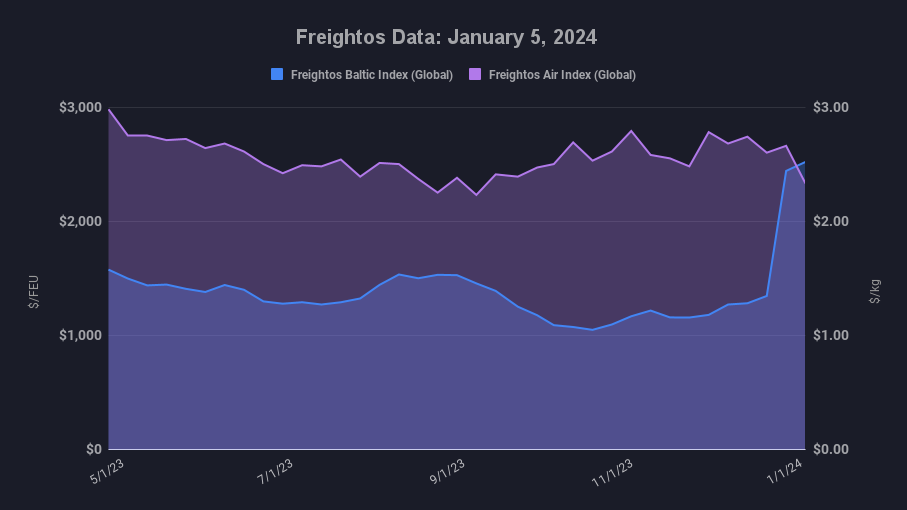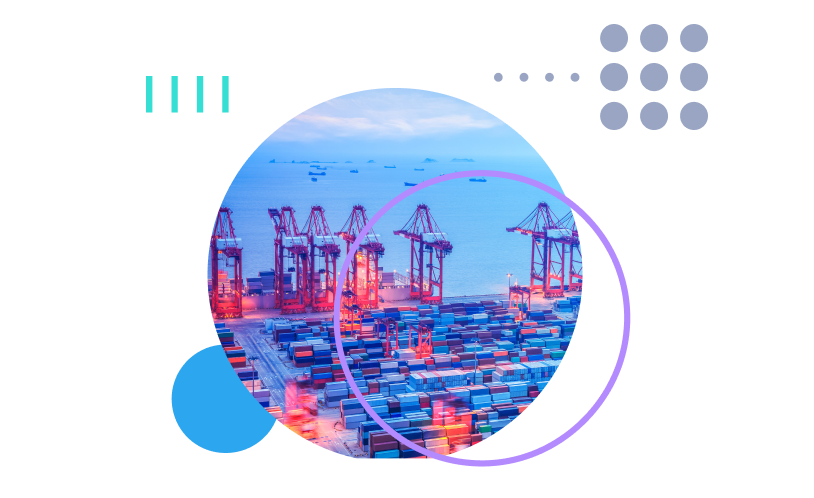Weekly highlights

Ocean rates – Freightos Baltic Index
- Asia-US West Coast prices (FBX01 Weekly) increased 60% to $2,713/FEU.
- Asia-US East Coast prices (FBX03 Weekly) increased 58% to $3,980/FEU.
- Asia-N. Europe prices (FBX11 Weekly) increased 176% to $4,391/FEU.
- Asia-Mediterranean prices (FBX13 Weekly) increased 115% to $5,169/FEU.
Air rates – Freightos Air Index
- China – N. America weekly prices fell 8% to $5.36/kg.
- China – N. Europe weekly prices fell 38% to $1.86/kg.
- N. Europe – N. America weekly prices fell 1% to $1.81/kg.
Dive deeper into freight data that matters
Stay in the know in the now with instant freight data reporting
Analysis
Last week authorities from a group of 12 nations, including the US and UK, issued a “final warning” for the Houthis to cease their Red Sea attacks, understood to be backed by a threat of strikes on Houthi targets in Yemen. This statement was followed by a China representative to the UN also calling for the attacks to end. At the same time, multiple nations have reportedly backed out or refused to publicly be included in the naval coalition now patrolling the area due to geopolitical considerations.
But the Houthis remain undeterred and have launched multiple attacks since then, including drones launched in the region, boats loaded with explosives, and a hijacking attempt via small-vessels.
With the continued attacks, six of the top ten container carriers are diverting away from the Red Sea: Maersk – which had returned and then suspended again last week – MSC, Hapag-Lloyd, ZIM, ONE and CMA CGM (though CMA CGM is still sailing some vessels through). Most Asian carriers – Evergreen, HMM, Yang Ming, OOCL and COSCO are not diverting, so container vessels are still using the Suez, but the total fleets of the carriers that are diverting represent 62% of global capacity.
COSCO has reportedly joined OOCL in ceasing Israeli port calls, possibly as a strategy to avoid becoming Houthi targets.
The diversions are leading to higher costs for carriers using more fuel and more ships for the longer journeys around the south of Africa, and higher container rates for shippers.
Freightos Baltic Index daily rates for Monday for the ex-Asia lanes that typically use the Suez Canal and which include Red Sea-related surcharges, were $4,234/FEU to N. America East Coast, a 69% increase since diversions started in mid-December. Asia – N. Europe rates of $4,789/FEU are 226% higher, and prices to the Mediterranean of $5,202/FEU are 116% higher. Prices are likely to continue climbing in the near term as mid-month GRIs and additional surcharges come into effect. Backhaul rates on these lanes have at least doubled as well as carriers seek to offset higher costs.
Asia – N. America West Coast rates have increased 74% to $2,713/FEU since mid-December as well, with reports that prices will climb to $5,000/FEU next week as shippers may be shifting volumes to the West Coast to avoid East Coast delays.
Planned rate increases to the West Coast and to other lanes not directly impacted by Red Sea diversions like the transatlantic – which are set to increase sharply in February to at least $5k/FEU from their current level of just $1,240/FEU – may reflect that capacity is tightening across the market as more vessels are activated on the ex-Asia lanes. They may also show that longer transit times and possible schedule disruptions on those lanes could lead to some port congestion at import hubs and to empty container shortages which likewise could be felt even beyond Red Sea services.
Demand is likely increasing as shippers try both to ship further in advance to accommodate longer transit times and to get orders out of China before manufacturing slows down over the Lunar New Year holiday that starts February 10th. So the next couple weeks will likely be the worst in terms of capacity shortages and possible congestion. As demand eases in late January, the industry may have a reprieve to recover schedules, and with a typical lull in volumes following Lunar New Year, freight rates may start to ease in late February – but should remain higher than usual until container traffic returns in full to the Red Sea.
But even if rates do climb to the $6k- $8k/FEU range, these would be well below the $15k/FEU level seen for Europe and Mediterranean rates and the $22k/FEU level for N. America East Coast containers caused by the extreme surge in volumes and port congestion during the pandemic.
Elevated freight rates are leading to expectations that carrier profitability will improve in 2024. Investment bank Jeffries raised its container carrier outlook for 2024 given the change in rate conditions and the possibility that they will lead to higher floor even as conditions stabilize.
Carrier stocks are reflecting these expectations and reacting to any signs that Red Sea traffic might recover, too: ZIM Lines, which is heavily exposed to the spot market, saw its stock jump 60% in December as widespread diversions began, fell double digits when Maersk announced they’d return to the Suez, and then rebounded when Maersk suspended Red Sea service again.
Recent reports that some carriers are negotiating with the Houthis to secure safe passage for their vessels led carrier shares to drop Monday, though Maersk and Hapag-Lloyd denied they were in talks with the Houthis.
Longer ocean transits are expected to push some volumes to air cargo. Through last week, Freightos Air Index rates for Asia – N. America were level and N. Europe continued their decline that began in mid-December, and would be typical for the weeks just post-peak season.
Daily rates for China – N. Europe on Monday, however, climbed to $4.11/kg, up 38% compared to the end of the year and possibly reflecting the start of an increase in demand caused by the Red Seas disruptions.
Freight news travels faster than cargo
Get industry-leading insights in your inbox.



